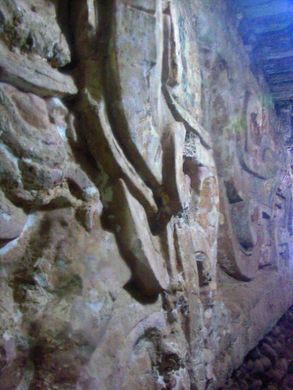Rosalila Temple (Copán, Honduras). It was unearthed under theAcropolis in 1991.The Rosalila Temple
Rosalila Temple (Copán, Honduras). It was unearthed under theAcropolis in 1991.The Rosalila Temple was the main religious sanctuary in Copán duringthe late 500s AD. Many artifacts with religious associations havebeen found, including: seven ceramic incense burners with charcoalstill inside (two of which were placed upon sculpted stone jaguarpedestals), offerings of flint knives (for sacrificing), nineelaborate ceremonial sceptres (wrapped in the remains of a deep bluebag or cloth), carved jade jewellery, stingray spines (forblood-letting rites), shark vertebrae, jaguar claws, and the remainsof flower petals and pine needles. Some of these things (inparticular the incense burners and flowers) are still used today bythe Maya in religious practices.Because of the deforestation of the Copán valley, this was the lastbuilding in the city to use such elaborate stucco decoration. Reducing limestone to plaster required vast quantities of firewood,and this was no longer feasible.Eventually, the Maya covered up the temple to build another structureon top of it. This was a common practice, but the Rosalila Templewas very carefully and ceremoniously buried, which was unusual. Theyused mud and stones to fill in the rooms, moldings and niches; andcovered the stucco with a thick layer of white plaster, whichprotected much of the original paint.A life-sized replica of the temple. -- source link
#history#architecture#maya mythology#geography#environmentalism#archaeology#deforestation#maya architecture#mesoamerica#maya#honduras#copán#rosalila temple#blood tw
